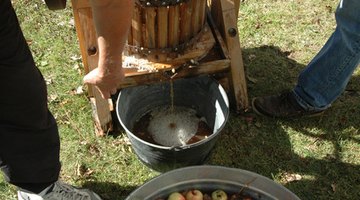How to Save an Old Cider Press
Old properties were sometimes built with detached stone cider houses on their grounds. According to Find A Property, one example, located on the grounds of Oldcroft cottage in Gloucestershire, United Kingdom, measures 4.75 meters by 3.85 meters (about 15.5 feet by 12.5 feet) and contains an original cider press.

Things You Will Need
- Ratchet
- Three-roll upset roller
- Cloth tape
- Drill
- Hand crank
- Hopper
- RustOleum Hammered spray
- Wood paint
- Protective gloves
Once saved and restored, antique cider presses make beautiful additions to old homes, and can be used for the original function: to create fabulous fruit ciders. There are different types of presses available in varying sizes. Designs such as the Weston press, the Buckeye or the ratchet-style press are well-known by restorers and enthusiasts.
-
Make a detailed list of all the components your old cider press. Some old presses may have pieces missing that have been lost along the way, or broken. Look out for the cider hoppers that mount on top of the grinder. If you are missing a component and need one to make the press function, you will need to purchase a new or used replacement.
-
Suspend the pressing plate (usually square and often made of oak) using a metal collar and thread the cast-iron fittings to the press screw so that the bottom part of the lower cast-iron component supports the pressing plate.
-
Link the higher of the two cast-iron fittings to the lower using a ratchet with two slots. The slots are positioned to allow movement of teeth on the lower fitting. Once the press comes into contact with the apples, the screw becomes free to turn and pushes down on the pulp rather than spinning the entire pressing plate. When the pressing plate is low enough to come in contact with the apples, pressure will be applied automatically resulting in a steady flow of juice from the bottom of the tub.
-
Create or restore the buckets, retaining where possible the original rims. If new ones are needed, roll them with a three-roll upset roller. Using a cloth tape, try to replicate the original style. It is better to drill holes in the buckets after forming the rims as the holes weaken the steel and cause bending.
-
Fit a hand crank so that you can operate the press. Ensure it is the right size for your set-up.
-
Install a hopper to hold your whole apples. The Jaffrey Wooden Hopper can hold up to 35 pounds of apples and improves the speed and ease of grinding, according to The Fruit Press.
-
Paint and preserve the surfaces using a good quality RustOleum and specialist wood paint or varnish. RustOleum Hammered sprays create the effect of battered metal, which looks appealing.
Tip
Make sure the pressing plate fits generously within the pressing tubs. Don't allow the flywheel to drag, as this will damage the press eventually. Consider the type of wood you have before painting or varnishing. For example, Correll presses, made in America, are constructed from ash, not oak, so require a different protective coat.
Warning
Cider presses are heavy so be sure you are prepared for transporting them safely if you purchase one that needs to be relocated.
Antique presses can contain very old, brittle wood that can splinter and cause damage to skin or break apart during moving. Take care when lifting components and try to wear protective gloves if possible.
References
Writer Bio
Natasha Parks has been a professional writer since 2001 with work published online and in book format for "Thomson Reuters," the "World Patents Index" and thomson.com. Her areas of expertise are varied and include physics, biology, genetics and computing, mental health, relationships, family crises and career development. She holds a Bachelor of Science in Biophysics from King's College, London.
Photo Credits
- cider making 2 image by alice rawson from Fotolia.com
- cider making 2 image by alice rawson from Fotolia.com
More Articles



